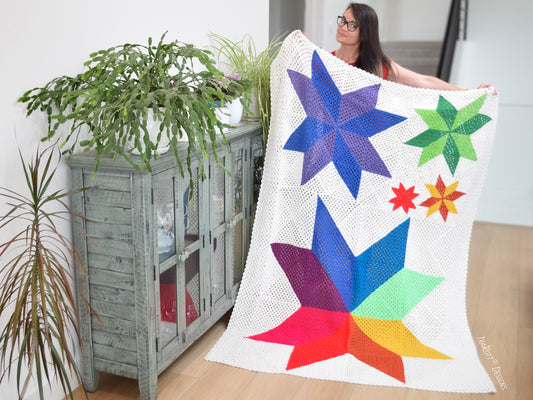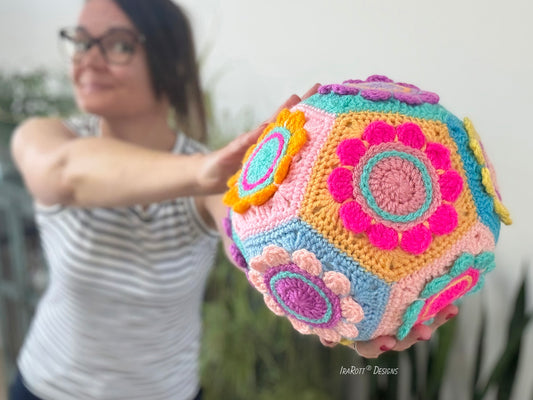Following our posts on Double Crochet (Part 1) and Single Crochet (Part 2), the question keeps coming: can Half Double Crochet (HDC) be made using both traditional and untraditional techniques? The answer is yes! In this Part 3 of our series, we’ll break down how Yarn Over (YO) and Yarn Under (YU) affect HDC, and what differences you can expect. Spoiler: It’s not as instantly “magical” as double or single crochet, but with a few adjustments, you can achieve professional-level symmetry and texture. Let’s get started!
How to make Half Double Crochet (HDC) - Two Ways
HDC is a speedy stitch where you pull yarn through all three loops at the end, but the YO vs YU difference occurs in the middle and influences how the finished stitch looks.
 |
Yarn Over (YO) HDC: 1. Yarn over, insert hook into stitch This stich is known as a Traditional HDC. |
 |
Yarn Under (YU) HDC: 1. Yarn over, insert hook into stitch This stich can also be referred as “Hook Over”. |
How HDC Stitches Affect the Joining Seam
In Part 1 and Part 2, we saw that traditional (YO) stitches form a visible slanted seam when working in the round, while (YU) stitches create a very straight seam.
So, will using the untraditional (YU) method make the joining seam perfectly straight in HDC stitches?
The answer: not quite. Unlike DC and SC stitches, HDC behaves a bit differently. With untraditional (YU) HDC, the seam is less slanted than with traditional stitches—but it still won’t be completely straight.
Why? HDC stitches naturally lean toward your dominant hand as you work. In traditional (YO) HDC, this lean combined with the offset stitch placement increases the slant of the seam. Untraditional (YU) HDC stitches are straighter, but they don’t fully compensate for the offset placement, so the seam remains slightly slanted.
In short:
- YO HDC → noticeably big slant
- YU HDC → milder slant
|
Yarn Over HDC |
Yarn Under HDC |
 |
 |
Preventing Slanted Seams
To reduce slanting in HDC projects, try turning your work at the end of each round. This alternates the direction of the stitches and helps counteract the natural lean.
Alternatively, you can work in continuous spiral rounds without joining, which eliminates seams altogether and avoids any slant.
Unlock HDC’s Hidden Textures
Unlike other crochet stitches, the top of a Half Double Crochet (HDC) stitch forms a set of double-sided V’s.
In right-handed crochet, the front-facing V’s point clockwise, while the back-facing V’s point counterclockwise. For left-handed crochet, the V’s face in the opposite direction.
Each pair of front and back-facing V’s shares a central bar. Normally, you insert the hook into the front-facing V’s to complete a standard HDC stitch. However, for creative texture, you can experiment by inserting the hook differently. Keep in mind that these improvised HDC stitches may slightly affect your gauge.
|
RIGHT Handed HDC |
LEFT Handed HDC |
 |
 |
Hidden Texture 1 - HDC Under 3 Loops
You can insert the hook under all 3 top loop of HDC, which is basically a space between stitches. In addition to a lovely texture, you can get a relatively straight-ish seam by using the untraditional (YU) method.
 |
 |
Hidden Texture 2 - HDC in Third Loop
Insert the hook under the third (back-facing) loop, leaving the front-facing V untouched. This produces a beautiful, knit-like texture and works well with both traditional and untraditional methods.
 |
 |
When to Choose YO vs YU (Final Notes)
Check your gauge first—traditional (YO) and untraditional (YU) HDC can differ slightly in height. If gauge isn’t critical, pick whichever feels comfortable, but stick to it for the whole project. Traditional (YO) HDC is easier on sore wrists, though it creates a very slanted seam and the edges may lean when mixed with traditional SC or other row work. Untraditional (YU) HDC stays straight, making it ideal to pair with straight stitches like traditional DC and SC for a neat, even finish.






